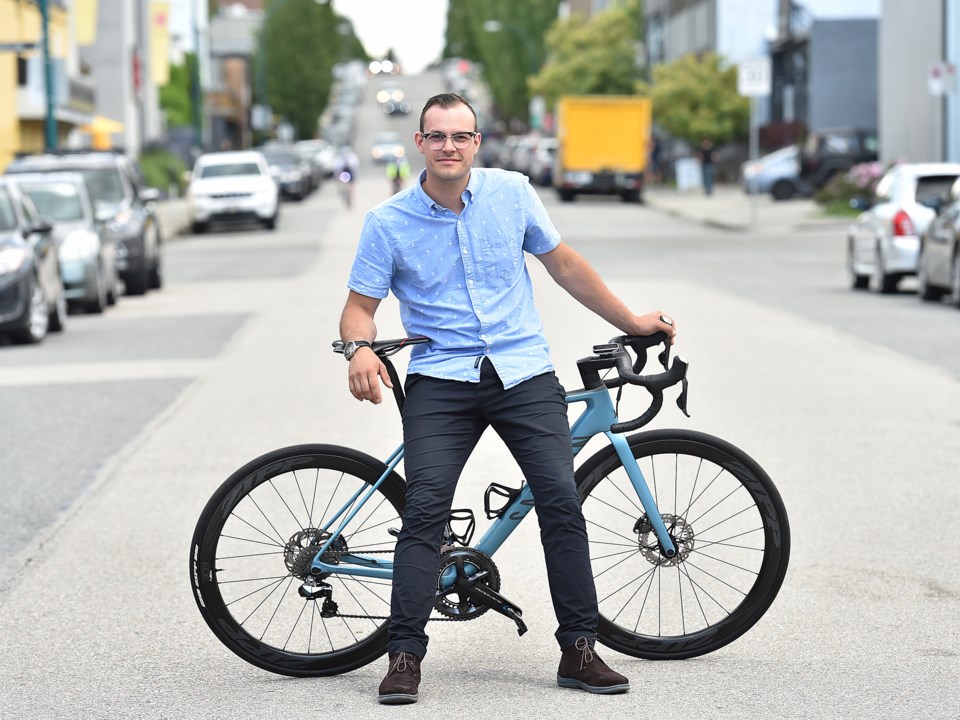Could a thumbs up or a simple wave of acknowledgement be the glue that binds the sometimes precarious relationship between Vancouver’s cycling community and vehicle drivers?
Boris Martin suggests it’s more complex than that. But a head nod is a good start.
Martin is the co-founder of the mobile bicycle repair firm Velofix. He’s been on a bike for most of his 26 years, first as a commuter and then riding semi-professionally across Canada and Europe.
He and others from the cycling community spoke to the Courier in the midst of Bike to Work Week to assess the sometimes fragile relationship between motorists and cyclists, the city’s bike infrastructure and both the known and unsaid rules of the road.
As someone who relies on both cars and bikes, Martin is in a unique position. In a short span of time, he could be in his car witnessing a cyclist fly through a four-way stop only to repeat that same move on his bike 10 minutes later.
“People make mistakes, so it’s better to just turn the other cheek,” Martin said. “We’ve got to stop having the ‘This was bad, f*** you’ conversation and move towards ‘Hey, thanks for stopping’ and emphasize when someone in a car does something right. A thumbs up on a bike, I think, goes a very long way.”
HUB Cycling’s acting executive director Laura Jane suggests proper route planning is the best way to ensure two-wheeled safety. Taking designated bike lanes whenever possible and riding at a leisurely pace are also key.
“Nearly all the serious crashes that occur in the City of Vancouver are because of drivers speeding, texting or simply not paying enough attention,” Jane told the Courier in an email. “We like to remind all people driving vehicles to be patient and respectful — and watch for people biking, especially before turning at intersections.”
Concerns around speed are not confined to motorists. As part of ongoing seawall upgrades, the city is installing signage throughout Stanley Park to emphasize the need to slow down. The speed limit on the seawall and other shared pathways is 15 km/h.
“The seawall is for slow cycling and is a shared path with many people meandering at a leisurely pace,” city spokesperson Maria Bekiaris told the Courier via email. “To aid those who are commuting who wish to move more quickly, we have added bike routes parallel to the seawall.”
Bekiaris also outlined a number of precautions cyclists must take: always wear a helmet, have lights on both ends of your bike, wear bright clothing and walk your bike across crosswalks. Situational awareness is also paramount. Be aware of your surroundings, make eye contact with other road users, put down your cellphone and take your earbuds out.
Having cycled semi-professionally in Belgium, Holland and Germany, Martin has seen those cultures adapt to sharing the road pretty seamlessly.
Making that comparison to Vancouver or even Canada, however, is a bit of a stretch.
“Cycling has been a culture in those countries longer than this country has been a country,” he said. “It’s just so deeply instilled both from a sport perspective and a mode of transportation perspective. It isn’t a conversation around ‘This is a good thing and we should do this.’ It’s a way of life and people are used to that.”
Martin argues Vancouver isn’t necessarily in need of more bike lanes to catch up with the Hollands of the world. He suggests Vancouver is home to some of the best cycling infrastructure in North America. Instead of building more, riding more will be the catalyst for change.
“Pushing to get more butts on bikes is part of the answer. I think there’s a lot of people who may have some resistance to cycling,” Martin said. “Getting more people on bikes to try it will help them see that it’s a viable mode of exercise or transport and will help that resistance diminish.”
More tips on achieving bike-car balance is online at www.vancouver.ca/walkbikeroll.
@JohnKurucz



